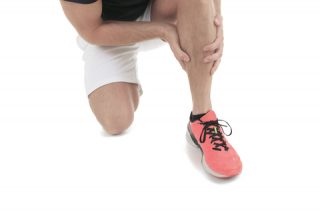Leg & Foot Pain – Is it the hip abductors? ألم الساق والقدم – هل هو خاطف الورك؟

Written by Michelle Champlin BSc Pod., M.Ch.S., S.R., Ch., (UK)
Weakened ‘core’ muscles can lead to issues in the legs, feet and ankles – such as over-pronation and associated foot or ankle pain. Especially amongst runners attending our clinic at Dubai Podiatry Centre, we have also seen issues such as Achilles tendonitis and plantar fasciitis where weakened core muscles have been a contributing factor. In particular the hip adductor and abductors. Runners and athletes who travel in a forward direction, with little or no lateral (side to side) movement are more at risk from developing weak hip abductors. Whenever there is focus on one sport or activity, there can be a risk of muscle imbalance in the legs and hips, without countering this with cross training.
The core muscles are extremely important in foot, ankle and leg muscle function. The core muscles include the stomach muscles (the rectus abdominus, transverse abdominus, external and internal obliques and erector spinae) and the hip abductors (the gluteus medius and gluteus minimus). If the core muscles are weak, then the pelvis will be unstable and this can lead to over-pronation (feet rolling inwards and flattened arches). The gluteus minimus and medius both primarily abduct the thigh. Weakness in the gluteals will have implications all the way down the musculo-skeletal chain. From heel contact to mid stance phase, if the gluteals are weak, then the thigh bone will adduct (move inwards towards the body’s midline) and internally rotate too much.
This then leads to the knee twisting outwards into a more ‘valgus’ position. The tibia will then excessively rotate internally relative to the foot in turn, leading to an increase in pronation at the foot and ankle. The smaller muscles in the leg and foot are not strong enough to resist the strong pronatory force of the body’s weight during gait if the core muscles are weak and not functioning properly.
Injuries and ailments linked in some cases to weak hip abductors include:
• Plantar fasciitis
• Achilles tendonitis
• Iliotibial band syndrome (ITBS)
• Medial tibial shin splints
• Patellofemoral pain
• Hip pain.
Treatment
There are also other causes and contributory factors in each of these conditions, so it’s important to see your Podiatrist for a full biomechanical assessment and treatment plan. This may include muscle strengthening and stretching advice and custom orthotics.
Dynamic exercises including the use of a medicine ball, rocker board, lunges and step-ups can be helpful in strengthening these muscles in runners. Yoga poses such as the ‘bridge’ can also be beneficial, as well as side and front planks. Injured runners can begin simply with side leg lifts too.
If you are experiencing hip, leg or foot pain, contact the Podiatrists at Dubai Podiatry Centre on +971 4 3435390 for a fast track return to fitness.
يمكن أن يؤدي ضعف العضلات “الأساسية” إلى مشاكل في الساقين والقدمين والكاحلين – مثل الإفراط في الميلان وما يرتبط به من آلام في القدم أو الكاحل. وخاصة بين العدائين الذين يترددون على عيادتنا في مركز دبي للعناية بالاقدام ، فقد شهدنا أيضًا مشاكل مثل التهاب وتر العرقوب والتهاب اللفافة الأخمصية حيث كان ضعف العضلات الأساسية عاملاً مساهماً. على وجه الخصوص، المقرب الورك والخاطفين. العدائين والرياضيين الذين يسافرون في اتجاه أمامي، مع حركة جانبية قليلة أو معدومة (من جانب إلى جانب) يكونون أكثر عرضة لخطر الإصابة بضعف عضلة الورك الخاطفة. عندما يكون هناك تركيز على رياضة أو نشاط واحد، يمكن أن يكون هناك خطر عدم توازن العضلات في الساقين والوركين، دون مواجهة ذلك بالتدريب المتقاطع.
تعتبر العضلات الأساسية مهمة للغاية في وظيفة عضلات القدم والكاحل والساق. تشمل العضلات الأساسية عضلات المعدة (عضلة البطن المستقيمة، وعضلة البطن المستعرضة، والعضلة المائلة الخارجية والداخلية، والعضلة الناصبة للورك) وعضلات الورك المبعدة (العضلة الألوية المتوسطة والعضلة الألوية الصغيرة). إذا كانت العضلات الأساسية ضعيفة، فسيكون الحوض غير مستقر وقد يؤدي ذلك إلى الإفراط في الكب (تدحرج القدمين إلى الداخل وتسطح الأقواس). الألوية الصغيرة والوسطى كلاهما يخطفان الفخذ في المقام الأول. سيكون للضعف في الألوية آثار على طول السلسلة العضلية الهيكلية. من ملامسة الكعب إلى مرحلة الوقوف المتوسط، إذا كانت الألوية ضعيفة، فإن عظم الفخذ سوف يتقارب (يتحرك نحو الداخل نحو خط الوسط للجسم) ويدور داخليًا أكثر من اللازم.
يؤدي هذا بعد ذلك إلى التواء الركبة للخارج إلى وضع “أروح” أكثر. سوف يدور الظنبوب بشكل مفرط داخليًا بالنسبة للقدم بدوره، مما يؤدي إلى زيادة في النطق عند القدم والكاحل. العضلات الصغيرة في الساق والقدم ليست قوية بما يكفي لمقاومة القوة القوية لوزن الجسم أثناء المشي إذا كانت العضلات الأساسية ضعيفة ولا تعمل بشكل صحيح.
تشمل الإصابات والأمراض المرتبطة في بعض الحالات بخاطفي الورك الضعفاء ما يلي:
• التهاب اللفافة الأخمصية
• التهاب وتر أخيل
• متلازمة النطاق الحرقفي الظنبوبي (ITBS)
• الجبائر الظنبوبية الوسطى
• ألم رضفة الفخذ
• ألم الورك.
العلاج: هناك أيضًا أسباب وعوامل أخرى تساهم في كل حالة من هذه الحالات، لذلك من المهم مراجعة طبيب الأقدام الخاص بك للحصول على تقييم ميكانيكي حيوي كامل وخطة علاج. وقد يشمل ذلك نصائح لتقوية العضلات وتمديدها وتقويم العظام حسب الطلب.
يمكن أن تكون التمارين الديناميكية بما في ذلك استخدام الكرة الطبية واللوح الهزاز والطعنات والخطوات مفيدة في تقوية هذه العضلات لدى العدائين. يمكن أن تكون أوضاع اليوغا مثل “الجسر” مفيدة أيضًا، بالإضافة إلى الألواح الجانبية والأمامية. يمكن للعدائين المصابين أن يبدأوا ببساطة برفع الساق الجانبية أيضًا.
إذا كنت تعاني من آلام في الورك أو الساق أو القدم، اتصل بأطباء الأقدام في مركز دبي للعناية بالاقدام
043435390 على الرقم لاستعادة لياقتك البدنية بسرعة







